
Sonic the Hedgehog has always been about the games. Say what you will about the comics, or the TV shows, or novels that feature tractors, but at the end of the day, Sonic the Hedgehog is a gaming franchise. While everything else can keep the icon in the public’s mind, SEGA has always been more concerned about how many units they can move than the plot of Sonic Underground. After all, that’s where they make their money. That’s where the state of the franchise is derived. That is what so many blogs and news sites focus on when they think “Sonic the Hedgehog.”
With Sonic’s 20th anniversary, there is going to be plenty of reflection on the franchise. I predict no less than fifty blog sites will put up “the top ten best Sonic games ever” that will feature the genesis games, Sonic CD, and Sonic Adventure in the top spots, with maybe the random “Sonic Advance” or “Sonic Triple Trouble” to break up the monotony. I know that, at least for me, I’m not going to sully the front page of this fine establishment with such a list. That is why I turn my attention for the moment on something that I am far too familiar with…the Archie Sonic the Hedgehog series.
No, this is not going to be a top ten list of “best single issues/arcs/anything.” Like I said in the beginning, the Sonic franchise has always been about gaming first, everything else second. So it’s only natural that, at some point, SEGA would tell whomever was making their promotional material to include adaptations for the game they were currently pushing. Depending on which side of the Atlantic you were on, you either got the U.K’s Sonic the Comic (whose loyal readership will swear up and down is the greatest thing ever) or you got the aforementioned Archie series. And the only real reason I’m starting with Archie is because of where I grew up. But hey, can you ever have enough Ken Penders jokes?
The first game adaptation Archie tackled was early on in the life of the series. After the initial four issue mini-series, Archie greenlit the regularly published comic, which was not much more than Adventures of Sonic the Hedgehog-esque tales using the cast and settings of the Saturday morning show. Scratch and Grounder were there and Sonic was being ridiculous, but the Knothole Freedom Fighters were fighting the good fight back in the Great Forest. It was a comic looking for its voice, and still hadn’t found it when its first game adaptation happened in issue six.
“The Spin Doctor,” written by Michael Gallagher with art by Dave Manak, was a direct adaption of the latest game in the Sonic series at that time, Sonic Spinball. That is, as direct as one can get in eight pages. The story starts off with Sonic and the rest of the Freedom Fighters (including pink-hued Princess Sally) running towards one of Dr. Robotnik‘s latest robot factories…only to find that it’s been shut down. The only clue as to what happened? A letter direct from the evil dictator of the planet, triumphing moving his factories into the volcanic Mt. Mobius, and that no one can stop him! Expectantly, Sonic rushes off to save the day…because if he didn’t, there wouldn’t be much of a story. It’s pretty convenient that his quick departure is alone, abandoning the rest of the Freedom Fighters so he can face Robotnik. I suppose it’s because Spinball only has you control Sonic, so they were staying true to the game!
Oh wait, Sonic Spinball is the only game that used any western influence (aside from Mean Bean Machine) and actually had all the Freedom Fighters in cameo roles. Including that version of Sally. But I guess having them kidnapped and being guarded by Scratch would have necessitated at least two more pages. Oh well. So Sonic arrives at the mountain (which he only knows exists because Robotnik told him) and tries to figure out a way past the moat of lava surrounding it. The perfect chance for Robotnik to strike!…by using a flipper and knocking Sonic all over the place. Pinball physics, anyone? It doesn’t take long for Sonic to realize the strange rails leading into the volcano are those from pinball machines, meant to shoot forward the ball and have it be played through. How very nice of the doctor to also install this into his fortress. Yes, I know it’s meant to be a trap and all that. But he could try and make it a little less obvious.
Over the next few pages, Sonic goes through the motions, showing the readers what they might find in the game. We get the Toxic Caves (with pink toxic waste…this isn’t Sonic the Hedgehog 2, you silly colorist!) with the two main robots in tow: Rexxon (the lizard that wants to eat you at the bottom) and Scorpious (the weird Eggman-looking thing that wants to eat you at the top) each taunting the hedgehog. Wait, not even Scorpious is Rexxon’s friend? How sad. Not like either of them have long to live. Then we go higher to Lava Powerhouse which Sonic uses a minecart to get to (oh god…wait that was only in Toxic Caves you’re trying to trick me comic) and runs into “Hip” and “Hop,” the two kangaroos who do absolutely nothing. Great work guys! 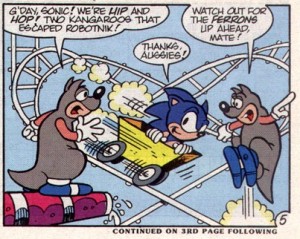 Then he goes even higher to The Machine, where Sonic doesn’t do much of anything himself. He sees a group of Mobiuns about to be robotocized and claims he is going to free them. And what better way to set them free than face off against Dr. Robotnik. Wait, shouldn’t he try breaking that machine first? Y’know, in case he loses or something?
Then he goes even higher to The Machine, where Sonic doesn’t do much of anything himself. He sees a group of Mobiuns about to be robotocized and claims he is going to free them. And what better way to set them free than face off against Dr. Robotnik. Wait, shouldn’t he try breaking that machine first? Y’know, in case he loses or something?
So Sonic jumps into “The Showdown,” only to find a television broadcasting Dr. Robotnik’s face. Instead of a climatic battle (or an episode of The Robotnik Show) the evil doctor catapults Sonic out of the fortress, sending him flying through the sky. It’s only because of Tails that Sonic is saved, and the blue hedgehog says to himself that he’s sure this isn’t over…
…but it is. There is an editor’s note asking people to write in if they want to see more of Sonic Spinball, but this is the only time in the series this mountain is seen. And Sonic doesn’t even win here! He doesn’t fight Robotnik, destroy the mountain, or even free the animals that were trapped. The only two that do escape, Hip and Hop, do it on their own accord, not Sonic’s. For all we know, Robontik’s plan to robotocize the entire planet was well underway! I mean, reading any issue beyond this shows otherwise, but…it would be forgivable if they had the intention of doing something beyond this. The rest of the issue is dedicated to a Sonic version of “A Christmas Carol,” which as I recall was not featured in the game at all (unless it was in a beta we don’t have). Are we supposed to assume that this is only a prequel to the game, and that the events in the cartridge are Sonic’s second foray into the mountain? Even though the ending leaves a lot to be desired, and the pacing has severe issues (as many stories in this era of the comic has) there is still a weird charm to it. Maybe because the staff behind it didn’t think the comic was going to last more than twenty issues at most. Heck, Ken Penders didn’t think the comic was going to live longer than issue 50. That’s why it was so crazy around that time!
Oh, and the cover showed Sonic wearing a tie. So it has that going for it.
Even though that was the first official adaptation in the comic, most people have forgotten about it because it really is just “another Sonic story from the comics.” It has become foggy, and likely merged together with Spinball‘s other adaptations in Adventures of Sonic the Hedgehog and the Saturday morning series. SEGA really wanted to whore out that game. And it wasn’t even the best of the year! Why didn’t they whore out Sonic CD like that? It would have been awesome to see an animated Little Planet in either show…those animated intros to the game were such teases…

No, when people think of adaptations in the Archie comics of the games, the first they think of is the Sonic the Hedgehog 3 story in issue thirteen, “This Island Hedgehog.” Once again drawn by Dave Manak, this is the first adaptation done by Ken Penders, the man who would steer the comic for the next hundred and fifty issues. However, Ken is only the co-writer, sharing duties with Mike Kanterovich, so it is a complete mystery which line is credited to who. The story starts with Sonic and Tails spotting a floating island, just out of nowhere. No reason given as to how they found it, or if they’re on a mission, just that it exists and is in their way. So Tails asks Sonic what he thinks is making the island float, and only one item comes to mind – a Chaos Emerald. Hey, that’s something from the games! Maybe this won’t be so bad after all! And there’s Knuckles‘ fist foreshadowing the introduction of the character, talking about rolling out the unwelcome mat…
…that subsequently knocks the plane out of the air. Oh. That’s…something special. Is it too picky of me to point out the fact the biplane which looks like the Tornado isn’t the right color? But at least Tails was flying it and not, say, Rotor or Antoine. I can give credit to the creative team for keeping out the Freedom Fighters at this point! So after Sonic and Tails exchange some punworthy dialogue, they encounter the very first sub-boss from Sonic 3, who shoots fire at our dynamic duo. “Holy 16-Bit Graphics!” Sonic gets covered by an energy shield unexpectedly, protecting him from being burnt to a crisp. But, knowing they’re not out of the woods (or jungle) yet, they jump into a nearby body of water, making a comment that I’m sure the Comics Code Authority wouldn’t have liked only a couple decades prior.
Sonic laments the fading of his new shield while him and his two-tailed friend bob about in the Hydrocity Zone, in which the comic demands we help out our heroes by pushing the buttons on my Sega Genesis. Hey, wait a minute! How am I to plug that into the comic?! I love how the comic then goes to insult me for not being quick enough…hey, maybe if those text boxes were smart, they’d tell Sonic how to reactivate that shield of his. It was in the manual, after all!
After being unable to scale the zone successfully, Sonic and Tails pass out, only to reawaken at the end of part one, tied up staring directly at the visage of Knuckles the Echidna, the guardian of the Floating Island and the Chaos Emerald that keeps it afloat. Wait, just one?
As part two begins, we see that (quite expectantly) Dr. Robotnik and his nephew Snively are the ones behind the encounter, Robotnik having tricked the guardian into thinking Sonic the Hedgehog is the enemy here. Watching through a hidden camera, the ruler of Mobius stares on as Sonic and Knuckles face off, and is baffled as Knuckles lets the two go, giving them “ten minutes” to get off the island and never return, else he’ll give them a “knuckles sandwich.” Not sure what that would taste like, but hey. After Knuckles assures Robotnik he’ll give Sonic and Tails “the business” if they don’t leave the island (oh god what) Robotnik quickly forgets his troubles when Crabmeat appears, wielding the Chaos Emerald and giving it to Robotnik. Guess it just got real.
Meanwhile, Sonic and Tails confirm to the readers they’re not about to run off, with Tails asking how they’re going to prove their innocence. Sonic replies that they won’t need to, and Robotnik will likely reveal his true colors soon enough. As if on cue (hey, we only have twelve pages here) Knuckles sees Sonic and Tails, and decides to cut them off to where he keeps the Chaos Emerald, as they’re heading in the general direction. And since Robotnik already has it? Knuckles finds it’s gone. Not the best hiding place, huh? Maybe next time don’t just leave it out in the open sitting on a random rock. When the duo arrive, Knuckles realizes he’s been played for a sap, and that Robotnik is the real villain.
Robotnik, in the interim, uses the emerald to power up his ship, preparing to leave the island. Of course, he wants to keep the emerald, but is unable to keep ahold as Sonic zips by, snatching it away. Knuckles reveals he knows of the deception, and the three defeat Robotnik’s SWATbots in a single panel. Now those are the kind of battles I love. Quickly, the villains escape, and Knuckles shows that for some reason he collected the remains of the fake-Tornado, just so Sonic could conveniently put it back together. And with that, Sonic and Tails fly off, leaving Knuckles alone with the feeling that he hasn’t seen the last of these two. And has history has shown, those suspicions proved to be correct…
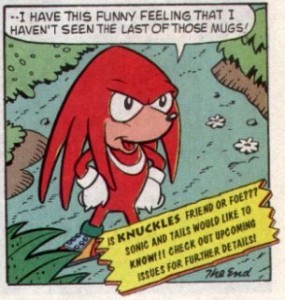 While it would be easy to be overly critical of the story, I find myself unable to do so. Maybe it’s because of the goggles of nostalgia, but if you look at it in the context of the other stories being published at the time (or even the other Sonic story in the comic) it comes off as something better than the rest. Sure, you have plenty of pop culture references which don’t make sense when Sonic’s world started turning into the more serious adventures of the issues in the 30’s and beyond, but how often do you have a Crabmeat quote the 60’s Batman television show? And hey, maybe one day Ian Flynn will explain what “Gotham City” is like on Angel Island. Even the fourth-wall breaking at the beginning of the second page showcases an innocence in the comic that would not last for much longer. In some ways, Knuckles was the herald of the “beginning of the end” of this carefree, Adventures of Sonic the Hedgehog styled storytelling. It would have been nice if the story was fleshed out, and took up the whole issue instead of only half, though. I mean, Sonic the Comic‘s adaptation took up multiple issues, and flowed pretty well into the Sonic & Knuckles adaptation they did…
While it would be easy to be overly critical of the story, I find myself unable to do so. Maybe it’s because of the goggles of nostalgia, but if you look at it in the context of the other stories being published at the time (or even the other Sonic story in the comic) it comes off as something better than the rest. Sure, you have plenty of pop culture references which don’t make sense when Sonic’s world started turning into the more serious adventures of the issues in the 30’s and beyond, but how often do you have a Crabmeat quote the 60’s Batman television show? And hey, maybe one day Ian Flynn will explain what “Gotham City” is like on Angel Island. Even the fourth-wall breaking at the beginning of the second page showcases an innocence in the comic that would not last for much longer. In some ways, Knuckles was the herald of the “beginning of the end” of this carefree, Adventures of Sonic the Hedgehog styled storytelling. It would have been nice if the story was fleshed out, and took up the whole issue instead of only half, though. I mean, Sonic the Comic‘s adaptation took up multiple issues, and flowed pretty well into the Sonic & Knuckles adaptation they did…
…but I’m getting off topic there. In the end, it is a fun little story. Even if it is pretty far removed from the game. The first level? You see that Angel Island is actually in the water, not floating as the name suggests. And it is a little odd that the writers completely ignore the Death Egg in any capacity…though they did revisit the concept later on. But I’ll get to that when I get to that. In another column. And it would have been nice to see the other areas of the island, like the fan favorite Ice Cap Zone, or even have the story be a cliffhanger. I can’t totally fault the creative team on that one, though. I’m certain SEGA didn’t exactly tell them Sonic the Hedgehog 3 was only the first half of the game, and that Sonic & Knuckles would pick up directly after Launch Base. Another zone that would have been nice to see in the comics. Actually, there was a lot in that game that would have been nice to see. Then again, this wasn’t the last time we saw Knuckles, the island, or its many locales.
One thing I didn’t mention is that the story was dedicated to Jack Kirby, considered one of the greatest comic artists and writers of all time, working side-by-side with Stan Lee to help build the original Marvel line of comics. By dedicating this story to that man, the creative team put themselves out on a limb, telling the world that, hopefully, one day, they would be able to master the craft of comic books in a way that came so easily to Jack Kirby. And though Ken Penders strove for that sort of greatness with his Knuckles’ line, he never quite made it. Then again, how many comic book creators today can say that they have?
So there you have it, the first two Sonic game adaptations that were part of the line. So what was to come next? Quite a few, believe you me. Floating islands, metallic hedgehogs, groups that were chaotic, pistol-wielding weasels…the Archie Sonicverse would never be the same. So stay tuned as we continue this magical journey down memory lane and reminisce about a kid’s comic book that has lasted eighteen years.
Wait a minute, the Sonic the Hedgehog 3 adaptation didn’t have one barrel in it! Maybe that’s why Ice Cap was missing…
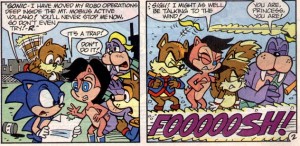
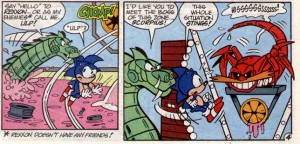
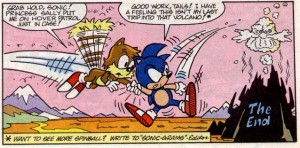
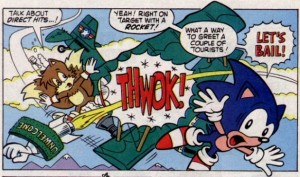
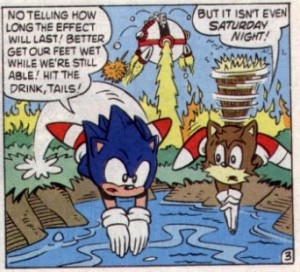
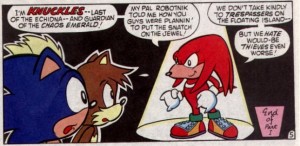
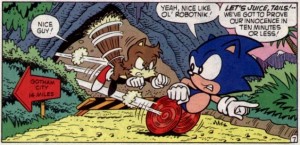
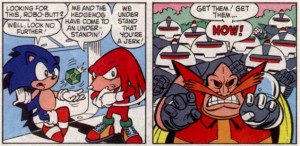
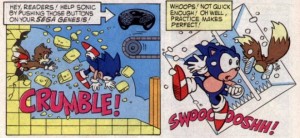
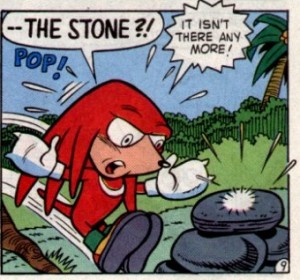
8 Comments
I found a pretty damned pristine copy of the Sonic Spinball crossover at a Salvation Army store last year, it as rather enjoyable – and helped increase my already mammoth Archie Sonic series collection. ^_^
Uh, didn’t issue 1 or 2 have a slight Sonic 2 reference where Sonic goes to Casino Night Zone? He even tells you to play the game.
Yes indeed! The first issue did have Sonic in the Casino Night Zone, just like issue four had the Sonic 2 special stage. I just didn’t review it for the simple fact it didn’t say explicitly that it was an adaption of Sonic 2, just that it used a single zone for a story where Sonic watched Robotnik for a bit and was thrown into a pinball machine until he broke it.
“The Robotnik Show” Lol, AOSTH could have been passed off as a Robotnik show. Sonic’s name may on it, but we all know who the real star of the show is.
I loved it when they actually bothered putting part of the stories into the comics rather than half-assing it and just throwing in a BUY THIS GAME like they do now, and just have five pages worth of the intro comic-ized. At least these adaptions have charm.
Well, that was a nice little history lesson. Too bad I’m too young to have read any of these comics.
Can’t wait for the next one.
“Gotham City – 14 Miles”
I guess Gotham City is located on Angel Island.
Radical. David. Excellent article. Awesome to read. Such a shame I only have the really recent sonic comics…